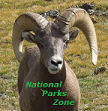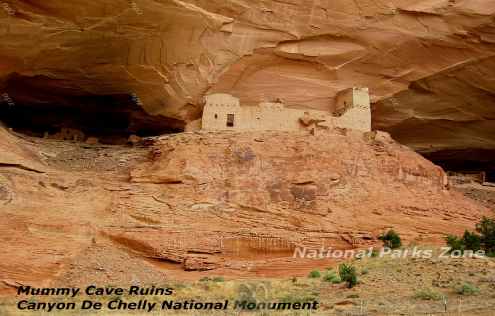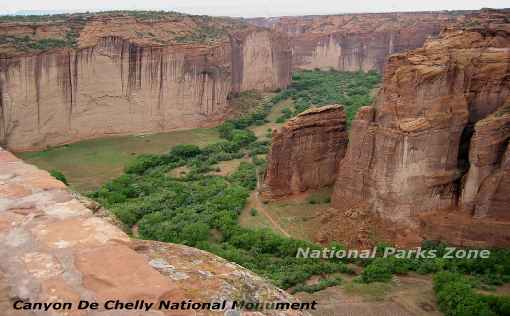Copyright © 2014-
All Rights Reserved

Updated 02/11/23 7:04 PM
Canyon De Chelly National Monument
Arizona's Canyon de Chelly comprises three magnificent canyons just outside the town of Chinle. The Navajo guides are knowledgeable and informative and will enhance your experience.
Arizona
2003, 2009
About the National Monument
Canyon de Chelly (pronounced de Shay) is one of the most visited national monuments in the U.S. It resides entirely on Navajo land and, as such, cannot be entered without a Navajo guide or guided tour. It is home to about 80 families who have resided there for generations.
It consists of three canyons, Canyon de Chelly, Canyon del Muerto and, the much smaller, Monument Canyon which branches off Canyon de Chelly just past Spider Rock.
It is worth noting that The Navajo prefer to be called the "Diné" which means “The People”. It is how they refer to themselves among themselves. I’ve never heard an outsider refer to them that way. You can read about the Navajo people from the link to their website below.
The canyon is located just outside town of Chinle, Arizona. Like the canyon itself it is entirely on Navajo lands. Alcohol is prohibited. Considering that the canyon does get a large amount of visitors there isn’t that much lodging within the town of Chinle. If you go online you find very quickly that they are showing you lodging in Kayenta, Arizona which is about 70 miles away. Not exactly what you want if your intent is to tour Canyon de Chelly.
Throughout the canyons there are a number of cliff dwellings which are very similar to those found in Mesa Verde, which is about 135 miles away, although nowhere near as big. When I was there the people who built the Mesa Verde cliff dwellings, and others through out the region, were typically referred to as the Anasazi – “the ancient ones”. Today, they seem to be referred to as “ancestral Puebloans”. I’m not exactly sure why that came about but one of our guides said that the translation of Anasazi, to the Navajo, was “ancient enemies”. Possibly, to the Navajo’s living in the canyon, the Anasazi weren’t their ancient ones and they wanted it to be clear about that.
You certainly want to take the time to drive along both the north and south rim drives. They are very scenic, have lots of overlooks where you can sit and have a box lunch, or just stop and take in the view. At one of these I found a Navajo with a blanket with assorted crafts and artifacts to sell on it. A fairly large chunk of petrified rock caught my eye. It was colorful, full of minerals and with lots of clearly identifiable bark but I shied away from buying it because I didn’t want to carry a 3½ pound rock in my suitcase home. I walked off but then walked back and bought it for five dollars. It sits in my family room.
Wildlife
The canyon is home to about 80 Navajo families who farm the area. You may see some deer and small mammals. This is not a place for wildlife viewing. It is for the beautiful scenic canyon, petroglyphs and a glimpse of Navajo culture that your guide will enlighten you with.
Lodging
The Thunderbird lodge is the only lodge in the park. I stayed there and it was nice and inexpensive. There is also a Holiday Inn and a Best Western in the town of Chinle both of which are within a half-
Hiking
White House Trail
You cannot hike into the canyon unguided with one exception. From the south rim drive there is the White House trail. It takes you from the rim, perhaps 600 feet above the canyon floor, down to the floor of the Canyon and across the canyon to the base of an ancient cliff dwelling -
Touring the Canyon
You can take a guided tour on their vehicles (recommended), take a tour by horseback or hire a Navajo guide at the National Parks Service visitor center and drive your own vehicle in (4WD recommended!). I drove in with a guide twice and it was both fun (and some exciting driving) and a great tour. The Navajo guides are very knowledgeable and well worth the price which was $20 per hour when I last did this (2009). You can figure about 4-
If you choose to drive into the canyon, in your own or a rented 4WD vehicle (remember, if you rent from any of the usual rental agencies, driving into these canyons will put you in violation of your contract). When you drive in you quickly hit the sands. About 3 miles of deep sand and your guide will tell you repeatedly to keep your speed up because there are points where you will be naturally inclined to slow down (like when you see a giant puddle, or a small pond, directly in your path).
The guide would tell me just follow the tracks into the water and then as we entered it he would point out some other tracks maybe 75 feet away coming out of the water, off to the side, and say head for those tracks. That was a bit exciting to say the least. It’s the kind of thing you would never do on your own because you have no idea how deep that giant puddle is. When you hit it the water splashes up right onto your windshield and you quickly have to put the wipers on so you can see where you’re going as you are plowing through the water. Fortunately there were only about two or three of these. Once you get past them it was pretty much just a dirt road that was in fairly good shape. The scenery is terrific, the guide pointed out petroglyphs, talked about the homesteads and the Navajo’s matriarchal society and the history of the canyon.
After we finished touring and dropped off our guide the next order of business was to find a car wash to wash off a car caked with dirt and red clay.
The next day driving up to Kayenta, Arizona to visit Monument Valley, I found that at 60 miles an hour there was a significant vibration. Needless to say I wasn’t happy about this, thinking that the vehicle was damaged, and I now have to go back to the rental car company to change cars (and deal with the how-
On my second trip on the way out we were driving through the sand, and doing a lot of slipping, and I thought it would be a good idea to be in a lower gear. I relayed that to Hector, our guide, who said okay if I want to. So I stopped and put it into a lower gear and, when I tried to continue, I found that I was stuck in the sand. We got out and dug and did everything we could to try to get the car free but nothing was working. Hector, who had cell phone service, called his nephew and a short while later we see a bareback rider galloping through the sand coming toward us with two shovels in his hand. He tied up his horse and helped dig us out. Once free we were able to continue and head back out of the canyon. For me that was a lesson that, as long as you are moving through sand, keep on moving. Stopping was not a good idea.
But, on the plus side I was able to video Hector’s nephew galloping in bareback, like the cavalry, coming to our rescue. When we got back to the National Park Service visitor center we gave Hector a very generous bonus for bailing us out of my stupidity and giving us a great memory (and video).
In the last photo Hector, our guide, is holding a small yellow toy shovel. Our friends, who drove into the back-
Canyon De Chelly National Monument Photo Gallery
Other Resources
Canyon De Chelly on the National Parks Service website -
Canyon De Chelly -
Ancestral Puebloans -
Navajo -
Tours into Canyon de Chelly
Lodging in Canyon de Chelly


Other National Parks and National Monuments Within a Day’s Drive:
Canyonlands National Park and Arches National Park These are places of steep canyons and iconic arches and are both outside of Moab, Utah and are about 200 miles to the north and about 3.5 hours.
Grand Canyon National Park The most famous canyon in the world is 225 miles to the west and about 4 hours to get to the South Rim. The North Rim is 275 miles to the west and about 5 hours.
Petrified Forest National Park Home of the Painted Desert and 225 million year old petrified logs 110 miles to the south and about 2 hours.
Mesa Verde National Park Home to ancient cliff dwellings set into a beautiful mesa is 163 miles to the northeast and about 3 hours.
Capitol Reef National Park Where you can see a giant fold in the Earth’s crust is 267 miles to the north and about 5 hours.
This national monument is on Navajo Tribal land and is as worthwhile to visit as any national park.
Monument Valley Tribal Park Famous for its massive sandstone buttes and as a backdrop for many a Hollywood western movie is about 100 miles northwest and about a 2 hour drive.
*N*P*Z*
National Parks Zone